北师大版小学英语四年级下册全册教学设计
小学四年级英语下册全册教学设计北师大版
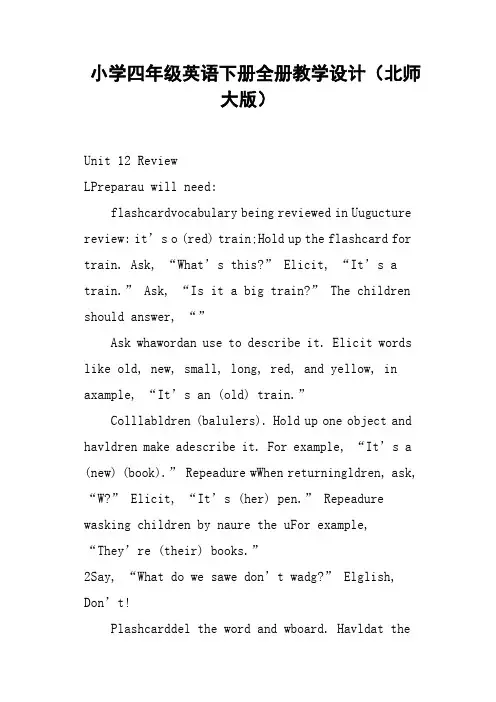
小学四年级英语下册全册教学设计(北师大版)Unit 12 ReviewLPreparau will need:flashcardvocabulary being reviewed in Uugucture review: it’s o (red) train;Hold up the flashcard for train. Ask, “What’s this?” Elicit, “It’s a train.” Ask, “Is it a big train?” The children should answer, “”Ask whawordan use to describe it. Elicit words like old, new, small, long, red, and yellow, in axample, “It’s an (old) train.”Colllabldren (balulers). Hold up one object and havldren make adescribe it. For example, “It’s a (new) (book).” Repeadure wWhen returningldren, ask, “W?” Elicit, “It’s (her) pen.” Repeadure wasking children by naure the uFor example, “They’re (their) books.”2Say, “What do we sawe don’t wadg?” Elglish, Don’t!Plashcarddel the word and wboard. Havldat theword after you.Aldren whaay ware aain station and want to buTry to elicit, “I walease.” or “How much a?/How muare?” AllaTalk abouudent Book pages 62 and 63Havldbooks at pages 62 and 63. Aquestionsabouures:Picture 1: “What do you think Danny is asking Bobby?”Picture 2: “What ads waiting for?”“What colain?”Picture 3: “What colain?” “Iad are waiting for?”Pictures 4/5: “Whalooking at?”Pictures 6/7/8: “What is happening now?”Picture 9: “Whadoing?”Picture 10: “Ibw?”udent Book pages 62 andSay, “Now we will hear whaaracters said.” Play the tape and havldren look aures as they lPlay the tape again, pausing at each picture. Havldat the words eaExplain that in Englle say Ouch! ware hurt.5.Flashcard gaThis game reviewvocabuladuced in Uugh 12. You will need the flashcardvocabulary being reviewed. Do not ulashcards for numbers or actionverbs.Divide the clawo teams. Put all the flashcards face down on a table betwaHave a child in Team A pick up a card and show it to Team B.(The children should take tug up the cards.) The child should ask,“A(dolls)?/Is this a (train)?”or “What’s this?/What a?”Together, Team B must answer, “They’re (doffs).” or “It’s a (train).”Points ad for evquestion andanswer.Lesson 2Preparau will need:aReviewure that each child has his/aShow your own copy anduung turtle. Ask, “Is this a young turtle?” The children should answer, “” Now ask, “Is this an old turtle?” Elicit, “N’t.”Continuubirds (big/small) and boy/girl(tall/short). Iaadure until allldren answer each quly.2.Lwordudent Book pagHavldbooks and look auand Mocky aage. Ask, “Where are Ken and Mocky?” Elanswer, “They are in a store.” Then ask, “W?” TheanswHavldren look abubblure, and read the wordxplain thaaskingags listedght hand side.Pladialog andape. Ask, “Dave a small train?” The answLundudent Book pagDldren’s abage. Show youage andure. Say the word goat and havldat it after youuve pictuPlawordape and havldatching picture. Repeawords.Play the tape again. Tavldren wumbwordbox nexatching picture.4.Read, trace and maudent Book pagShow youage. Puamburger and ask, “What’s this?” The children should answer, “It’s a hamburger.” Then havldren find the matching phraRepeadure for allable.Read each phraTavldren draw ag each phrauwudent Book page 65Explain that you waldluLesson3 Preparau will need:children's cards for Uugh 12Talk togudent Book pagHavldren turn to page 66. Draw their aage. Show youage. Pure and ask,“Whoboug?”Elicit,“Danny.”Then ask,“Whosold?”Elicit,“Bobby.”Modeldialog and havldaafter you.Divide the clawo groups and havldat the dial a roleplay. (One group is Danny andgroup is Bobby.) Puldairs and havadialog. Encouragubstitute dumbFd dialogure and ask, “What animials didain?” Tadure useddialog. (Three groups are needed) Encouragldubstitute danimals and animalFor example, substitute small cats for big cows, and meow, meowFd dialogure and ask, “What happened?” Tadure usedd dialog. (Divide the clagroups.) Havldren substitute dbody parts. The child who plauldabody that is hurt. For example, havldan ear ways, “My ear hurts.” 2.Review wordsHave a childlass. Par and ask, “What’s this?” The class should answer,“It’s (her) ear.”Repeaduabody listedargage.3.Write wordudent Book pagDldren’s abagw youage an day, “What’s this?” Try to elicit, “It’” Wwordboard. HavldwordlbRepeaduaining words.4.Listen and circludent Book pagHavldbooks at pagw youage andwures. Tellat only one word has ad/c/soundwords.Play the tawords. Havldat. Say,“Which word hasthe d/c/s ound?” Havuch the wordbPlay the tape agaavldle out the word that has the d/c/ sound.5.Snap!Ugaview the vocabuladucedbIt is best played in paHavldren take ouards for Units 7~12.See Uage 50ules and proceduLucturereview:a/Divide the clawo teams. Put alld and drink flashcards for Unit 9 face down on a table betwaHave a child in Team A pick up a card and show it to Team B. The child should ask, “What’s this?”Together, Team B must answer, “A (hamburger).” or “Some (rice).” Tld in Team A asks, “Is t his (hamburger) hot?” The children in Team B should answer, “” or“N`t.”Havams take turns at asking and answering the quuntilldren have asked a quPoints ad for eaquestion and answer.2.Structure review: Is he/she (eating) (some soup)? lawo teams. Explain thaTeam A willan eating and drinking activxample, eating hot souldaating hot soup, andbam answer quTeam B.The members of Team B muguactivity. They couldask, “Is (she) drinking milk?”Team A should answer, “No, (she) isn`t.”When Team B has guessed the activust find oudld. They should ask,“Iup hot?”Team A should answer, “” Havams change roles after an activity has bly guessed.Remindldd wordave learned.Points ad for eaquestion and answer, andly guessing the activLet’s singStudent Book pagHavudbooks at page 68. Draw their aure. Aalk abouure. You can ask qulike “What aldren doing?”, “Aappy?”Repeat the words, aloudldren. Havat after you.Play the tape straight through. Havldren claands waPlay the tape again. Turagg.Play the tape. Havldren stand in a circle and walk up and dowle wuwudent Book pagTellldg the new songamilies。
2017年新教材北师大版小学英语四年级英语下册精品教案全册
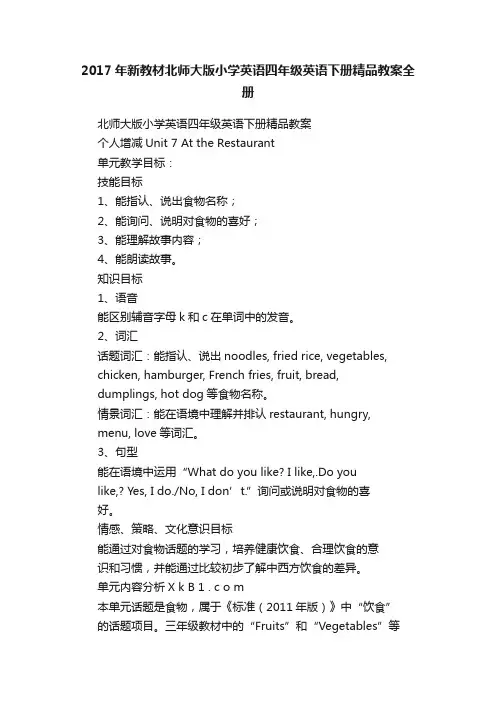
2017年新教材北师大版小学英语四年级英语下册精品教案全册北师大版小学英语四年级英语下册精品教案个人增减Unit 7 At the Restaurant单元教学目标:技能目标1、能指认、说出食物名称;2、能询问、说明对食物的喜好;3、能理解故事内容;4、能朗读故事。
知识目标1、语音能区别辅音字母k和c在单词中的发音。
2、词汇话题词汇:能指认、说出noodles, fried rice, vegetables,chicken, hamburger, French fries, fruit, bread,dumplings, hot dog等食物名称。
情景词汇:能在语境中理解并排认restaurant, hungry,menu, love等词汇。
3、句型能在语境中运用“What do you like? I like,.Do youlike,? Yes, I do./No, I don’t.”询问或说明对食物的喜好。
情感、策略、文化意识目标能通过对食物话题的学习,培养健康饮食、合理饮食的意识和习惯,并能通过比较初步了解中西方饮食的差异。
单元内容分析X k B 1 . c o m本单元话题是食物,属于《标准(2011年版)》中“饮食”的话题项目。
三年级教材中的“Fruits”和“Vegetables”等单元都属于该话题,而且说明个人喜好的句型“I likebeans.”以及noodles等相关词汇在前面的学习中也已渗透。
教师可以结合这些相关内容,引导学生学习新语言。
在语境中学习和使用“What do you like? I like/I don’tlike,.Do you like,? Yes, I do./No, I don’t.”询问和个人增减回答对食物的喜好是本单元主要语言学习内容。
以上主要句型都是在Mocky和Ken一家人到餐馆就餐,相互询问喜欢什么食物的过程中自然呈现。
Mocky想知道Ken和Ann喜欢什么食物,于是引出了“What do you like? I like,,”句型。
北师大版小学英语四年级下册全册教学设计
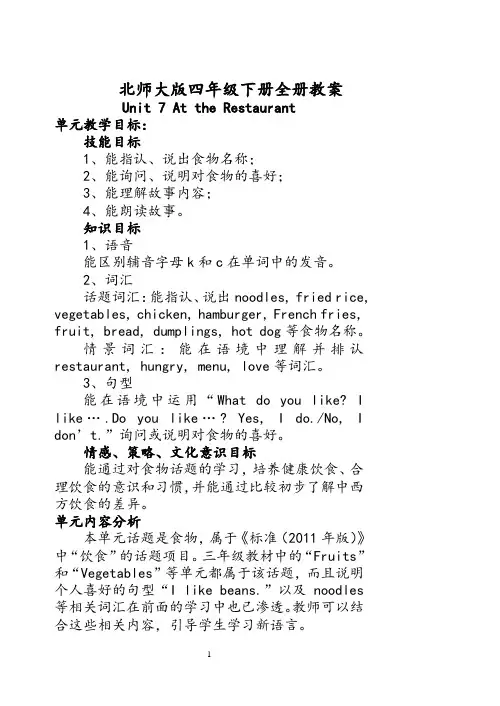
北师大版四年级下册全册教案Unit 7 At the Restaurant单元教学目标:技能目标1、能指认、说出食物名称;2、能询问、说明对食物的喜好;3、能理解故事内容;4、能朗读故事。
知识目标1、语音能区别辅音字母k和c在单词中的发音。
2、词汇话题词汇:能指认、说出noodles, fried rice, vegetables, chicken, hamburger, French fries, fruit, bread, dumplings, hot dog等食物名称。
情景词汇:能在语境中理解并排认restaurant, hungry, menu, love等词汇。
3、句型能在语境中运用“What do you like? I like….Do you like…? Yes, I do./No, I don’t.”询问或说明对食物的喜好。
情感、策略、文化意识目标能通过对食物话题的学习,培养健康饮食、合理饮食的意识和习惯,并能通过比较初步了解中西方饮食的差异。
单元内容分析本单元话题是食物,属于《标准(2011年版)》中“饮食”的话题项目。
三年级教材中的“Fruits”和“Vegetables”等单元都属于该话题,而且说明个人喜好的句型“I like beans.”以及noodles 等相关词汇在前面的学习中也已渗透。
教师可以结合这些相关内容,引导学生学习新语言。
在语境中学习和使用“What do you like? I like/I don’t like….Do you like…? Yes, I do./No, I don’t.”询问和回答对食物的喜好是本单元主要语言学习内容。
以上主要句型都是在Mocky和Ken一家人到餐馆就餐,相互询问喜欢什么食物的过程中自然呈现。
Mocky想知道Ken和Ann 喜欢什么食物,于是引出了“What do you like? I like…,”句型。
后来,Ken和Ann意识到Mocky 不认识菜单,在帮助Mocky点菜时,引出“Do you like noodles? Yes, I do./ No, I don’t.”等一般疑问句及回答。
北师大版小学四年级英语下册教学设计
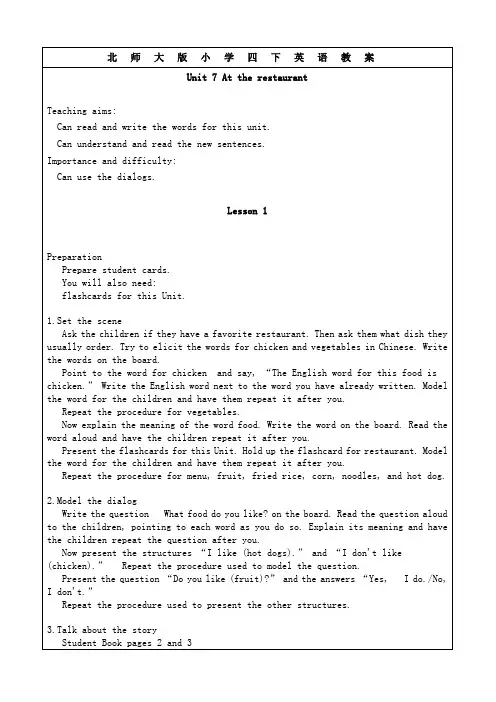
Now explain the meaning of the word food. Write the word on the board. Read the word aloud and have the children repeat it after you.
Picture 1: “Who can you see in the pictures?”
“Where are they going?”
Picture 2: “What are they reading?”
Pictures3/4/5: “What do you think Mocky, Ken, and Annare talking about?”
Point to the word for chicken and say, “The English word for this food is chicken.” Write the English word next to the word you have already written. Model the word for the children and have them repeat it after you.
5.Set homework
Encourage the children to tell the story to their families.
Lesson 2
Preparation
You will need:
flashcards for this Unit.
1.Review
Review the flashcards for this Unit.Hold up the flashcard for restaurant.Ask, “What's this?” Elicit, “It's a restaurant. ”
北师大版四年级英语下册教学计划
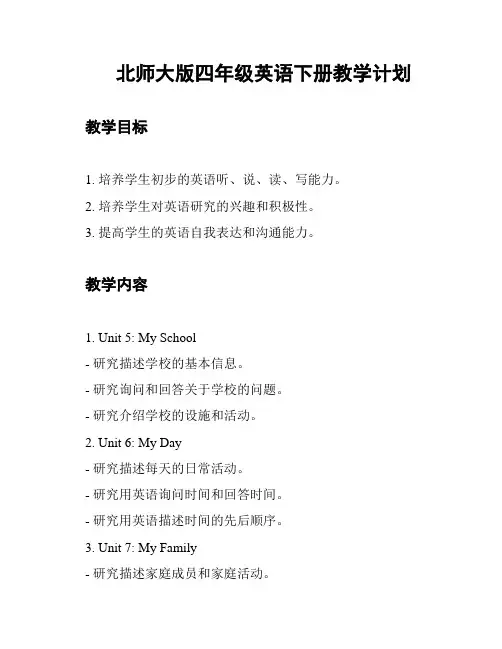
北师大版四年级英语下册教学计划教学目标1. 培养学生初步的英语听、说、读、写能力。
2. 培养学生对英语研究的兴趣和积极性。
3. 提高学生的英语自我表达和沟通能力。
教学内容1. Unit 5: My School- 研究描述学校的基本信息。
- 研究询问和回答关于学校的问题。
- 研究介绍学校的设施和活动。
2. Unit 6: My Day- 研究描述每天的日常活动。
- 研究用英语询问时间和回答时间。
- 研究用英语描述时间的先后顺序。
3. Unit 7: My Family- 研究描述家庭成员和家庭活动。
- 研究用英语询问和回答关于家庭的问题。
- 研究介绍自己的家庭。
教学活动1. 听力训练- 利用录音材料进行听力训练,培养学生对英语的听辨能力。
- 组织各种听力练,如听音选图、听音排序等。
2. 口语练- 进行角色扮演活动,让学生能够自然运用英语进行交流。
- 组织小组讨论,让学生能够用英语表达自己的观点和意见。
3. 读写训练- 组织课文朗读和角色配音活动,培养学生的口语表达和阅读能力。
- 组织写作训练,让学生能够写出简单的英语句子和段落。
教学评价1. 随堂小测验- 在课堂上进行小测验,检查学生对所学知识的掌握情况。
- 结合学生的表现,及时给予反馈和指导。
2. 作业和考试- 布置课后作业,巩固学生的研究成果。
- 定期进行考试,评估学生的英语水平和进步情况。
教学资源1. 课本:北师大版四年级英语下册2. 录音材料:课本配套录音文件3. 课件:利用PPT等多媒体工具进行教学展示以上为北师大版四年级英语下册教学计划,旨在培养学生的英语听、说、读、写能力,提高学生的英语自我表达和沟通能力,希望能够激发学生对英语学习的兴趣和积极性。
北师大版四年级英语下册全册精品教案(教学设计)

T: In this holiday, I went to some supermarket, hotel and many friends’house for Chinese new year. So I’mso happy. Did you have a good holiday?
4.Let students know they should save the time and helpeach other.
课前准备
Courseware, audiocassette recorder, new words cards
板书设计
Unit 7 Today is Monday
Monday What day is it today? It’s Monday. / Today is Monday.
Ask the students to make a new dialogue in their groups. And then act it out.
Who’d like to introduce yourself?
Step 2. Flashcard activity
1. Present the flashcards for this Unit. Play the courseware for Monday. Model the word and have the children repeat it after you.
3. Now present the question form, What day is it today? Write the question on the board and explain its meaning. Read the question aloud. Point to the words as you do so. Have the children repeat the question after you.
【范文】小学四年级英语下册全册教学设计(北师大版)
小学四年级英语下册全册教学设计(北师大版)本资料为woRD文档,请点击下载地址下载全文下载地址www.5ykj.com Unit12ReviewLesson1Preparationyouwillneed:•flashcardsforthevocabularybeingreviewedinUni ts7through11..Structurereview:it’sotrain;his,her,my•Holduptheflashcardfortrain.Ask,“what’sthis?”Elicit,“It’satrain.”Ask,“Isitabigtrain?”Thechildrenshouldanswer,“yes,itis.”•Askwhatotherwordstheycanusetodescribeit.Elic itwordslikeold,new,small,long,red,andyellow,inasent ence,forexample,“It’santrain.”•collectsomeclassroomobjectsfromthechildren.H olduponeobjectandhavethechildrenmakeasentencetodesc ribeit.Forexample,“It’sa.”Repeattheprocedurewiththeotheritems.•whenreturningtheitemstothechildren,ask,“whosepenisit?”Elicit,“It’spen.”Repeattheprocedurewithotheritems.,askingchildrenbyn ametoensuretheuseoftheir.Forexample,“They’re books.”2.Setthescene•Say,“whatdowesaytosomeoneifwedon’twantthemtodosomething?”ElicittheterminEnglish,Don’t!•Presenttheflashcardforticket.modelthewordand writeitontheboard.Havethechildrenrepeatthewordafteryou.•Askthechildrenwhattheysaywhentheyareatthetra instationandwanttobuysometickets.Trytoelicit,“Iwantsometickets,please.”or “Howmucharethetickets?/Howmuchisthefare?”Allofthesearecorrect.3.TalkaboutthestoryStudentBookpages62and63Havethechildrenopentheirbook satpages62and63.Askthesequestionsaboutthepictures: Picture1:“whatdoyouthinkDannyisaskingBobby?”Picture2:“whatarethefriendswaitingfor?”“whatcoloristhetrain?”Picture3:“whatcoloristhistrain?”“Isthisthetrainthefriendarewaitingfor?”Pictures4/5:“whatismockylookingat?”Pictures6/7/8:“whatishappeningnow?”Picture9:“whatismockydoing?”Picture10:“Ismockybetternow?”4.StoryStudentBookpages62and63•Say,“Nowwewillhearwhatthecharacterssaid.”Playthetapeandhavethechildrenlookatthepicturesasthe ylisten.•Playthetapeagain,pausingateachpicture.Haveth echildrenrepeatthewordseachtime.•ExplainthatinEnglishpeoplesayouch!whentheyar ehurt.5.FlashcardgameThisgamereviewsthecorevocabularyintroducedinUnits7t hrough12.youwillneedtheflashcardsforthevocabularybeingreview ed.Donotusetheflashcardsfornumbersoractionverbs.•Dividetheclassintotwoteams.Putalltheflashcar dsfacedownonatablebetweentheteams.•HaveachildinTeamApickupacardandshowittoTeamB .Thechildshouldask,“Arethese?/Isthisa?”or“what’sthis?/whatarethese?”•Together,TeamBmustanswer,“They’re.”or “It’sa.”•Pointsarescoredforeverycorrectquestionandcor rectanswer.Lesson2Preparationyouwillneed:•oppositesmaster.ReviewEnsurethateachchildhashis/hercopyoftheoppositesmast er.•Showyourowncopyandpointtothepictureoftheyoun gturtle.Ask,“Isthisayoungturtle?”Thechildrenshouldanswer,“yes,itis.”Nowask,“Isthisanoldturtle?”Elicit,“No,itisn’t.”•continueforthepicturesofthebirdsandboy/girl .Ifnecessary,repeattheprocedureuntilallthechild renanswereachquestioncorrectly.2.ListenforwordsStudentBookpage64•Havethechildrenopentheirbooksandlookatthepic tureofkenandmockyatthetopofthepage.Ask,“wherearekenandmocky?”Elicittheanswer,“Theyareinastore.”Thenask,“whoisthestorekeeper?”Theanswerismocky.•Havethechildrenlookatthespeechbubblesinthepi cture,andreadthewordstothem.Explainthatkenisaskingifmockyhasthethin gslistedontheright handside.•Playthefirstdialogandstopthetape.Ask,“Doesmockyhaveasmalltrain?”Theanswerisyes.3.ListenforsoundsStudentBookpage64•Directthechildren’sattentiontothebottomofthepage.Showyourcopyofthepageandpointtothefirstpicture.Saythewordgoatan dhavethechildrenrepeatitafteryou.continuefortheotherfivepic tures.•Playthefirstwordonthetapeandhavethechildrenp ointtothematchingpicture.Repeatfortheotherwords.•Playthetapeagain.Thistimehavethechildrenwrit ethenumberofthewordintheboxnexttothematchingpicture.4.Read,traceandmatchStudentBookpage65•Showyourcopyofthepage.Pointtothepictureofthe hamburgerandask,“what’sthis?”Thechildrenshouldanswer,“It’sahamburger.”Thenhavethechildrenfindthematchingphrase.•Repeattheprocedureforalltheitemsonthetable.•Readeachphraseoncemore.Thistimehavethechildr endrawa1ineconnectingeachphrasetoitscorrectpicture.5.SethomeworkStudentBookpage65Explainthatyouwantthechildrentocol orthepictures.Lesson3Preparationyouwillneed:•children'scardsforUnit7through12..TalktogetherStudentBookpage66•Havethechildrenturntopage66.Drawtheirattentiontothetopofthepage.Showyourcopyofthepage.Pointtoth efirstpictureandask,“whoboughttheticketsinthestory?”Elicit,“Danny.”Thenask,“whosoldthetickets?”Elicit,“Bobby.”•modelthesentencesinthefirstdialogandhavethec hildrenrepeatthesentencesafteryou.•Dividetheclassintotwogroupsandhavethechildre nrepeatthedialaroleplay.•Putthechildreninpairsandhavethempracticethed ialog.Encouragethemtosubstitutedifferentnumbersofti ckets.•Fortheseconddialog,pointtothepictureandask,“whatanimialsdidmockyseefromthetrain?”Thenrepeattheprocedureusedforthefirstdialog.Encoura gethechildrentosubstitutedifferentanimalsandanimaln oises.Forexample,substitutesmallcatsforbigcows,andmeow,meowformooooo,mooooo•Forthethirddialog,pointtothepictureandask,“whathappenedtomocky?”Thenrepeattheprocedureusedfortheseconddialog.Haveth echildrensubstitutedifferertbodyparts.Thechildwhopl aysmockyshouldpointtothepartofthebodythatishurt.For example,havethechildpointtoanearwhenheorshesays,“myearhurts.”2.Reviewwords•Haveachildcometothefrontoftheclass.Pointtohi sorherearandask,“what’sthis?”Theclassshouldanswer,“It’sear.”•Repeattheprocedurefortheotherpartsofthebodyl istedinthemarginofthispage.3.writewordsStudentBookpage66•Directthechildren’sattentiontothebottomofpage66.Showyourcopyofthepage andpointtotheeye.Say,“what’sthis?”Trytoelicit,“It’shereye.”writethewordontheboard.Havethechildrencopythewordon thecorrectlineintheirbooks.•Repeattheprocedurefortheremainingwords.4.ListenandcircleSudentBookpage67•Havethechildrenopentheirbooksatpage67.Showyo urcopyofthepageandpointtothefirstrowofpictures.Tell themthatonlyonewordhasadifferent/c/soundinthefirstt hreewords.•Playthetapeforthefirstthreewords.Havethechil drenrepeat.Say,“whichwordhasthedifferent/c/sound?”Havethemtouchthewordontheirbooks.•Playthetapeagainthistimehavethechildrencircl eoutthewordthathasthedieffrent/c/sound.5.Snap!Usethisgametoreviewthevocabularyintroducedinthisboo k.Itisbestplayedinpairs.•HavethechildrentakeouttheircardsforUnits7~12.•SeeUnit8,page50,fortherulesandprocedure.Lesson41.Structurereview:a/some•Dividetheclassintotwoteams.Putallthefoodandd rinkflashcardsforUnit9facedownonatablebetweenthetea ms.•HaveachildinTeamApickupacardandshowittoTeamB .Thechildshouldask,“what’sthis?”Together,TeamBmustanswer,“A.”or“Some.”ThenthechildinTeamAasks,“Isthishot?”ThechildreninTeamBshouldanswer,“yes,itis.”or“No,itisn`t.”•Havetheteamstaketurnsataskingandansweringthe questionsuntilmostchildrenhaveaskedaquestion.Pointsarescoredforeachco rrectquestionandanswer.2.Structurereview:Ishe/she?•keeptheclassinthetwoteams.Explainthatthistim e,TeamAwillchooseaneatinganddrinkingactivity,forexa mple,eatinghotsoup.onechildintheteammimeseatinghots oup,andtheothermembersintheteamanswerquestionsfromT eamB.•ThemembersofTeamBmusttrytoguesstheactivity.T heycouldask,“Isdrinkingmilk?”TeamAshouldanswer,“No,isn`t.”•whenTeamBhasguessedtheactivity,theymustfindo utifthefoodishotorcold.Theyshouldask,“Isthesouphot?”TeamAshouldanswer,“yes,itis.”•Havetheteamschangerolesafteranactivityhasbee ncorrectlyguessed.•Remindthechildrenofotherfoodwordstheyhavelearned.•Pointsarescoredforeachcorrectquestionandansw er,andforcorrectlyguessingtheactivity.4.Let’ssingStudentBookpage68•HavetheStudentopentheirbooksatpage68.Drawthe irattentiontothepicture.Askthemtotalkaboutthepictur e.youcanaskquestionslike“whatarethechildrendoing?”,“Aretheyhappy?”,etc.•Repeatthewords,aloudtothechildren.Havethemre peatafteryou.•Playthetapestraightthrough.Havethechildrencl aptheirhandswiththetape.•Playthetapeagain.Thistimeencouragethemtojoin inthesong.•Playthetape.Havethechildrenstandinacircleandwalkupanddowninthecirclewiththemusic.5.SethomeworkStudentBookpage68Tellthechildrentosingthenewsongtotheirfamilies.www.5ykj.com。
【北师大版】小学四年级下册英语教案
【北师大版】小学四年级下册英语教案小学英语四年级(下册)学期计划表Unit 7 At the Restaurant单元教学目标:技能目标1、能指认、说出食物名称;2、能询问、说明对食物的喜好;3、能理解故事内容;4、能朗读故事。
知识目标1、语音能区别辅音字母k和c在单词中的发音。
2、词汇话题词汇:能指认、说出noodles, fried rice, vegetables,chicken, hamburger, French fries, fruit, bread, dumplings, hot dog 等食物名称。
情景词汇:能在语境中理解并排认restaurant, hungry, menu, love等词汇。
3、句型能在语境中运用“What do you like? I like….Do you like…? Yes, I do./No, I don’t.”询问或说明对食物的喜好。
情感、策略、文化意识目标能通过对食物话题的学习,培养健康饮食、合理饮食的意识和习惯,并能通过比较初步了解中西方饮食的差异。
单元内容分析本单元话题是食物,属于《标准(2011年版)》中“饮食”的话题项目。
三年级教材中的“Fruits”和“Vegetables”等单元都属于该话题,而且说明个人喜好的句型“I like beans.”以及noodles等相关词汇在前面的学习中也已渗透。
教师可以结合这些相关内容,引导学生学习新语言。
在语境中学习和使用“What do you like? I like/I don’t like….Do you like…? Yes, I do./No, I don’t.”询问和回答对食物的喜好是本单元主要语言学习内容。
以上主要句型都是在Mocky和Ken 一家人到餐馆就餐,相互询问喜欢什么食物的过程中自然呈现。
Mocky想知道Ken和Ann喜欢什么食物,于是引出了“What do you like? I like…,”句型。
北师大版英语四下全册教案教学设计23
Unit 7 At the restaurantLesson 1教学内容:1、Structures (New)What food do you like?I like (chicken).Do you like (fruit)?Yes, I do. / No, I don’t.2、V ocabularyCore: a restaurant, a menu, food, fruit, vegetables, chicken, a hot dog,French fries, a hamburger, fried rice, noodles, a cornContextual: Here’s the restaurant.教学目标:把握询问对方喜爱什么食品的句型。
教学重点:(1)把握句型的正确运用。
(2)熟练读出单词。
教学难点:(1)like的正确明白得。
(2)个别单词的发音及意思。
教具预备:1、学生卡片2、预备本单元的教学卡片教学过程:1.情形引入(1)问学生,他们是否有最喜爱的餐厅。
问他们通常会点什么菜。
试着引导学生说出“鸡肉”和“蔬菜”,把汉字写在黑板上。
(2)指着“鸡肉”说:“那个词对应的英语是chicken”,并写在旁边。
给学生示范,让学生跟读。
(3)用同样的方法学习vegetables。
(4)给学生说明“food”的意思,把单词写在黑板上,示范朗读,让学生跟读。
(5)展现本单元的教学卡片。
拿出教学卡片restaurant。
给学生示范朗读,让学生重复。
(6)用同样的方法学习单词menu, fruit, fried rice, corn, noodles, hot dog。
2.示范句型(1)在黑板上写出句子What food do you like?指着每个单词给学生示范朗读那个问句。
说明句子的意思让学生跟读。
(2)出现I like(hot dogs)和I don’t like (chicken).(3)出现问句Do you like (fruit)?和回答Yes, I do. No, I don’t.(4)用同样的方法出现其余的句型。
北师大版小学英语四年级下册全册教案
北师大版小学英语四年级下册全册教案目录Unit 7 At the Restaurant《Lesson 1 What do you like》 (2)Unit 7 At the Restaurant《Lesson 3 Have fun.》 (12)Unit 7 At the Restaurant《Lesson 6 Round up.》 (17)Unit 8 Talent Show《Lesson 1 I'm from China.》 (21)Unit8 Talent Show《Lesson 2 He's thin,but he's strong.》 (28)Unit 9 Hot Soup《Lesson 1 I'm thirsty.》 (36)Unit 9 Hot Soup《Lesson 2 What's your favorite food》 (40)Unit 9 Hot Soup《Lesson 3 Have fun.》 (49)Unit 10 Mocky’s Store《Lesson 1 Can I help you》 (55)Unit 10 Mocky’s Store《Lesson 2 Can I have the blue one,please》 (66)Unit 11 Illness《Lesson 1 My tumny hurts.》 (69)Unit 12《Review》 (72)Unit 7 At the Restaurant《Lesson 1 What do you like?》1教学目标1.知识与技能。
能听,会说,拼读词汇:noodles, chicken, vegetable, bread,fruit.会认读hamburger, French fries, fried rice。
能用句型“what do you like ?”“I like.....”来询问别人喜欢什么及表达自己的喜好。
- 1、下载文档前请自行甄别文档内容的完整性,平台不提供额外的编辑、内容补充、找答案等附加服务。
- 2、"仅部分预览"的文档,不可在线预览部分如存在完整性等问题,可反馈申请退款(可完整预览的文档不适用该条件!)。
- 3、如文档侵犯您的权益,请联系客服反馈,我们会尽快为您处理(人工客服工作时间:9:00-18:30)。
北师大版四年级下册全册教案Unit 7 At the Restaurant单元教学目标:技能目标1、能指认、说出食物名称;2、能询问、说明对食物的喜好;3、能理解故事内容;4、能朗读故事。
知识目标1、语音能区别辅音字母k和c在单词中的发音。
2、词汇话题词汇:能指认、说出noodles, fried rice, vegetables, chicken, hamburger, French fries, fruit, bread, dumplings, hot dog等食物名称。
情景词汇:能在语境中理解并排认restaurant, hungry, menu, love等词汇。
3、句型能在语境中运用“What do you like? I like….Do you like…? Yes, I do./No, I don’t.”询问或说明对食物的喜好。
情感、策略、文化意识目标能通过对食物话题的学习,培养健康饮食、合理饮食的意识和习惯,并能通过比较初步了解中西方饮食的差异。
单元内容分析本单元话题是食物,属于《标准(2011年版)》中“饮食”的话题项目。
三年级教材中的“Fruits”和“Vegetables”等单元都属于该话题,而且说明个人喜好的句型“I like beans.”以及noodles 等相关词汇在前面的学习中也已渗透。
教师可以结合这些相关内容,引导学生学习新语言。
在语境中学习和使用“What do you like? I like/I don’t like….Do you like…? Yes, I do./No, I don’t.”询问和回答对食物的喜好是本单元主要语言学习内容。
以上主要句型都是在Mocky和Ken一家人到餐馆就餐,相互询问喜欢什么食物的过程中自然呈现。
Mocky想知道Ken和Ann 喜欢什么食物,于是引出了“What do you like? I like…,”句型。
后来,Ken和Ann意识到Mocky 不认识菜单,在帮助Mocky点菜时,引出“Do you like noodles? Yes, I do./ No, I don’t.”等一般疑问句及回答。
在故事情境中还呈现了restaurant, hungry, menu和love等词汇,教学中引导学生结合情景理解即可。
故事中体现了Ken 和Ann对Mocky的关照,可以在教学中注意挖掘,并传递关爱他人的意识。
结合话题组织学生交流时,应渗透合理膳食的意识,并引导学生了解中西方饮食文化的差异。
Learn to Say提供了餐厅情景,扩充了食物词汇,如fried rice, vegetables,hamburg-er, French fries, fruit和bread等,这些词汇并未在故事中出现,都需重点学习。
学生对购买食品的情景并不陌生,因此教师可安排情景表演,引导学生在表演中体会、感知和巩固“What do you like?I like….”等句型。
也可创设合理的情景,如鼓励学生制作本班学生的“最喜爱食物”合集,促使学生通过模仿使用核心句型进行询问和表达,在语境中体会句子的语义功能,并尝试运用语言。
Talk Together是小朋友看菜单、准备点菜的场景,图中的小朋友正在相互询问对方喜欢什么食物。
为了增强语言学习的实用性并体现对学生思维能力的培养,教师可以引导学生观察菜单的内容,如食物和价钱等。
也可设计新的菜单,添加学生学过的蔬菜、水果和食品。
教学中注意引导学生在真实的情境下指认食物,并尝试运用“Do you like…?Yes, I do./ No, I don’t.”交流对食物的喜好。
Game Time呈现了一个有关食物的游戏。
游戏中学生既要回答上一个同学的问题,还要询问一下同学喜欢什么食物。
学生可以在有意义的交流中,使用单元的主要语言“What do you like? I like….”体会句型的语用功能。
在游戏中要注意交流的真实性,要给学生充分的思考时间。
也可以引导学生说一说为什么喜欢或不喜欢某种食物,综合运用更多的语言,体现语言的真实运用。
Show Time 呈现了一幅大图和四幅小图,再现了单元故事的基本情节。
学生需要回忆情节并使用所学语言“演故事”。
在模仿表演时,要鼓励学生充分发挥创造力,使用自己的语言演故事,提升学习的主动性。
Listen and Repeat着重发展学生语音意识与能力,本册教材主要呈现辅音字母在单词中的发音。
本单元呈现的是字母c在单词中的两种发音,在呈现方式上用不同颜色的阴影区别辅音字母在单词中的发音,作为视觉提示。
教学中注意引导学生通过跟读、模仿,体会、区分字母c在单词中的两个发音/s/和/k/,并准确发音。
本册教材的Trace Write安排了根据图片和例句信仿写的活动。
在本单元的书写活动中,学生需要观察图片的情景,然后选择正确的食物单词,根据图片写出完整的句子。
在学生写的过程中,教师还要提示学生注意书写规范,例如单词之间的间隔、句首字母大写、结尾用英文标点等。
Uncle Booky’s Storytime提供了一个拓展阅读的小故事,讲述的是两个孩子和线亲一起为父亲选择生日礼物和食品的内容,复现了本单元的主要词汇与语言结构。
故事适合学生独立阅读,教师在指导过程中可以渗透关爱父母意识的培养。
第一课教学目标:1、能读懂故事主要内容,利用插图理清故事主要情节;2、能模仿录音朗读故事人物对话;3、能借助图片正确指认和说出食物的名称;4、能在故事情境中理解询问或说明喜欢什么食物的句型“What do you like? I like….”;5、能通过比较和学习,了解中西方饮食的异同。
教学重点:1、理解询问和说明喜欢什么食的句型“What do you like? I like….”的意义;2、借助插图理解并正确朗读故事人物对话。
教学难点:Restaurant和menu的发音。
教具准备:配套教学光盘,教学卡片,人物头像。
教学建议:Get Ready1、猜谜游戏教师出示食物的剪影图片,学生猜测食物名称,如apple, banana, orange, icecream等。
T:Guess. What food is it?(设计意图:复习一些简单的食物名词,建立新旧知识间的联系。
通过就本课话题进行预先讨论,为新知学习做铺垫。
并呈现情景图片,为学生理解故事话题和情景做铺垫。
)2、说一说(1)引导学生说一说他们喜欢的食物。
T: We know so much food. I like apples. What do you like?Ss: I like….(2)教师结合学生上个环节所说的内容,呈现食物图片和单词,并带读,如noodles,chicken 等。
(3)教师引导学生思考在哪些场所可以看到这些食物,引出新词restaurant。
T:Where can we see the food?Ss: In the supermarket/shop/market/restaurant.设计意图:Listen and Read1、导入故事呈现故事第一幅插图,引导学生观察、指认插图内容,如图中都有谁,他们在哪,他们将要做什么等。
T:Who can you see? Where are they? Whatwill they do?2、学习故事(1)让学生猜一猜主人公是否进入这间餐厅。
T: Do they go into the restaurant?(2)让学生先完整看一遍连环画,确认猜测是否正确。
然后呈现图2,引导学生关注“I’m hungry.”并猜一猜每个人物分别喜欢哪些食物。
T: Guess. What food do they like?(3)整体播放故事动画,教师呈现相应的食物图片,引导学生找出Ken和Ann分别喜欢什么食物。
T: What does Ken/ Ann like?(4)回顾故事主要内容。
把主人公头像和食物图片贴到黑板上,让学生说一说每个人物分别喜欢什么食物。
(5)让学生猜一猜Mocky喜欢什么食物。
3、模仿表演(1)让学生独立阅读故事。
(2)播放录音,让学生指人物,集体跟读对话。
(3)学生独立朗读对话。
(4)让学生根据图片和语言提示,补全对话。
教师可以删除部分人物对话,让学生看插图补全句子。
(5)呈现插图或人物头像,教师说相应的句子,让学生判断是否正确。
(6)鼓励学生分小组朗读或表演故事,并在全班呈现。
(设计意图:通过引导学生观察主题图,提高学生猜测情节、想象和预测的能力。
通过设置问题,引导学生关注、理解故事大意。
结合插图理解故事细节信息,明确所学语言的表意功能及运用的合理性。
通这联系自身,运用本课新知句型进行表达,再次巩固语言及其意义。
)Learn to Say1、呈现情景(1)利用插图或人物面具,总结故事主要情节,引导学生说一说他们喜欢什么食物。
T: Ann and Ken like noodles and chicken.I like apples. What do you like?(2)呈现Learn to Say的插图,引导学生观察图片的场景,说一说图中人物可能在讨论些什么。
(3)播放录音,让学生指一指、说一说Li Wen 喜欢什么食物。
2、学习表达(1)让学生猜一猜第一个男孩喜欢什么食物。
让学生看插图,指一指、说一说食物的名称。
(2)利用卡片呈现食物的名称,让学生跟读、指认。
(3)播放录音,让学生跟读并指认相应的插图。
然后教读单词,让学生指食物图片。
3、练习运用(1)出示插图,让学生说相应的食物名称。
(2)把插图和单词贴在黑板上,让学生做图文匹配。
(3)播放对话录音,让学生跟读。
然后让学生扮演第一个小男孩,说一说他喜欢什么,补全对话。
(4)教师引导学生说一说自己喜欢什么,然后问一问周围的同学分别喜欢什么食物。
T:I like noodles. What do you like?/ What about you?(5)把学生分成小组,在小组中进行问答。
(设计意图:通过在情景中引导学生听音跟读核心词汇和句型,再次建立图片、语音、语意之间的联系,巩固新知。
)Listen and Number(1)先让学生看教材中插图的内容,说一说插图中食物的名称。
(2)放录音,让学生完整地听一遍,边听边用手指相应的图。
(3)放录音,让学生边听边给插图标上序号。
(4)再次播放录音,每次放一句,教师重复,让学生说出是哪一幅图。
全班一起核对完成情况。
(设计意图:根据插图预测,渗透听力策略的培养。
渗透学习习惯的培养。
让学生了解中西方饮食的差异。
)Homework:朗读连环画故事人物对话,完成采访。
Lesson 2 Do you like fruit?一、教材分析本课主要教学内容有三部分,包括配图故事(Ⅱ)对话学习和歌曲。
